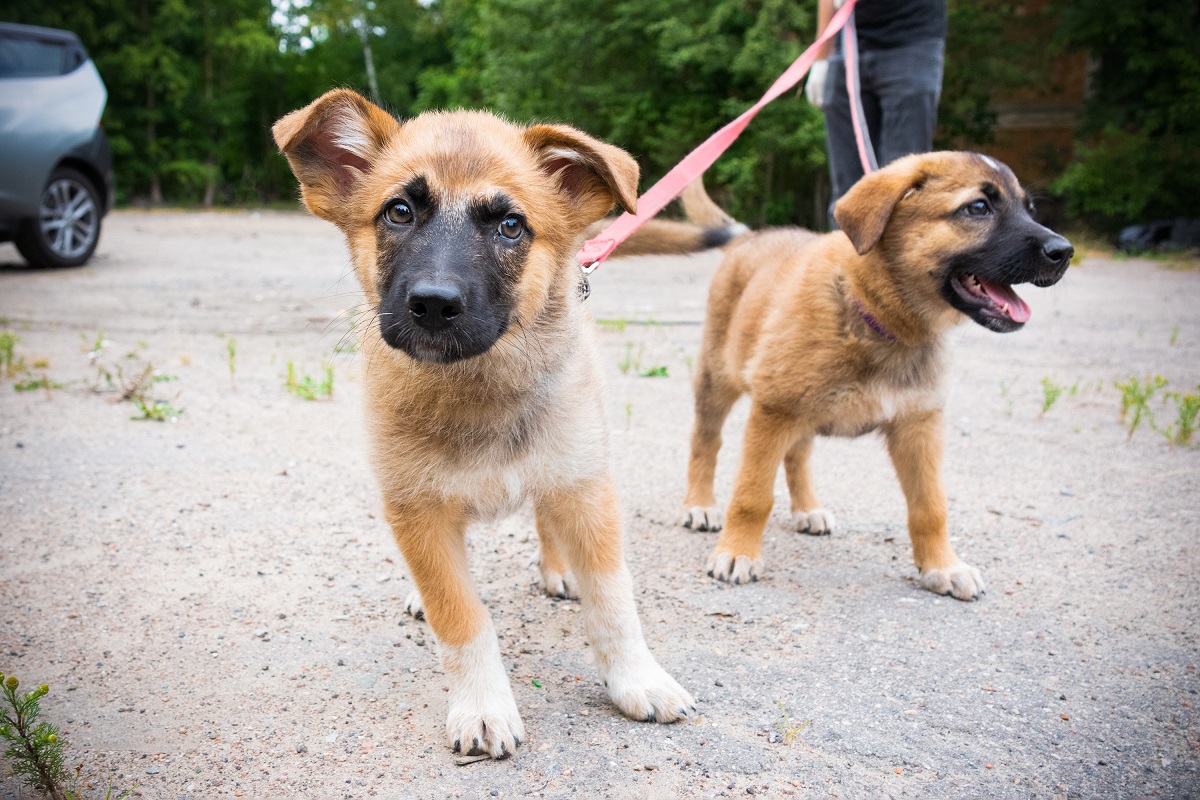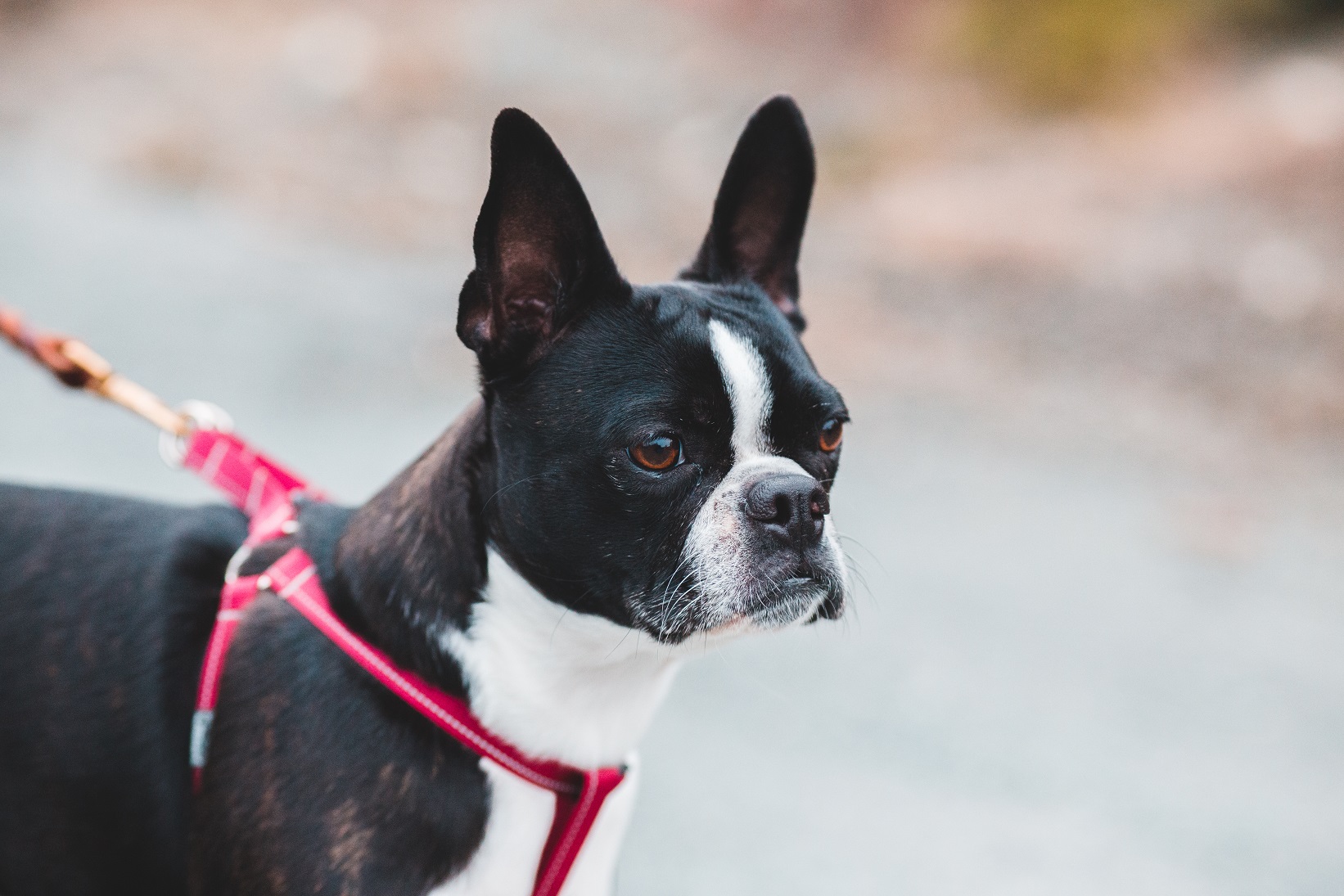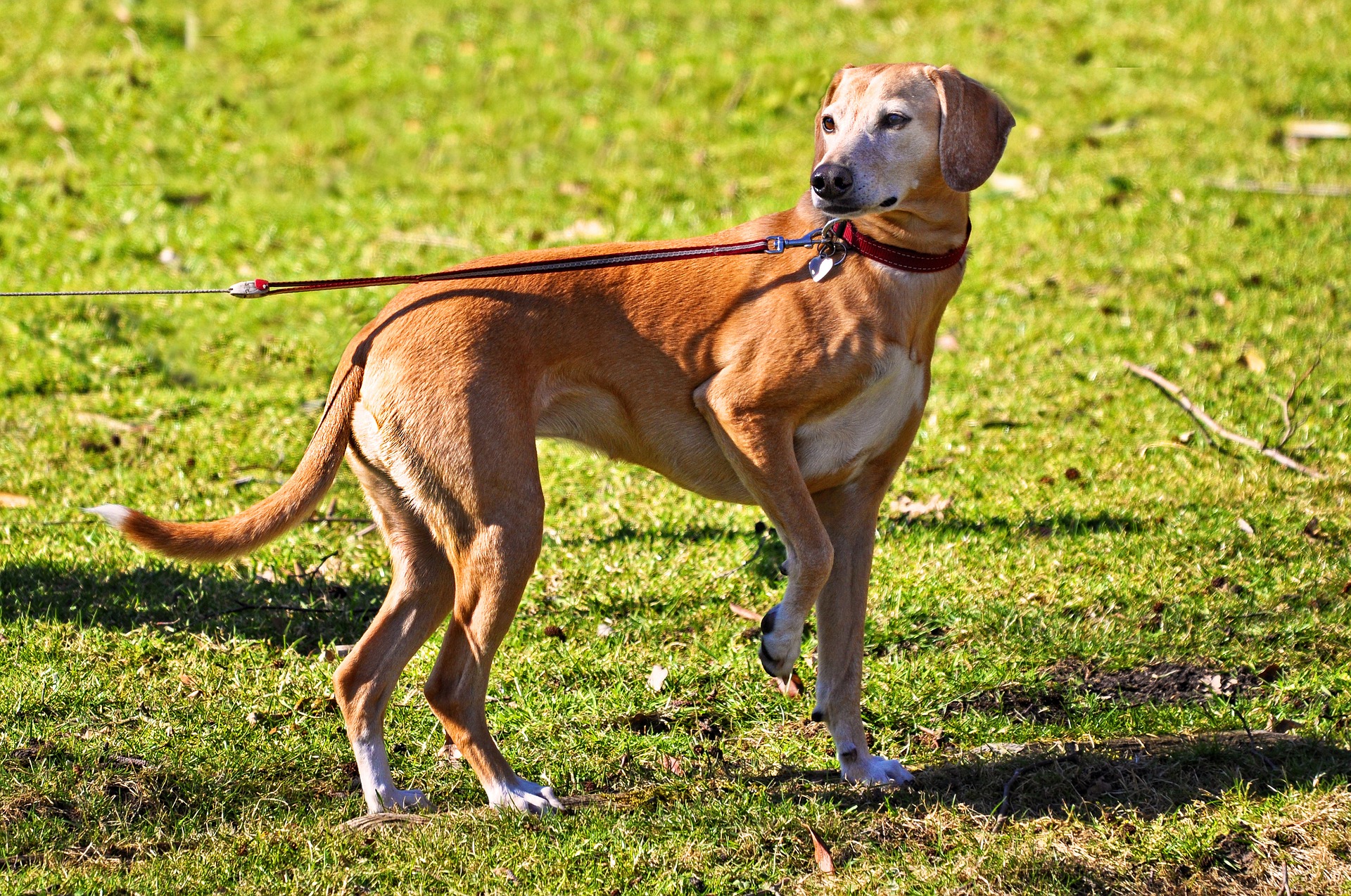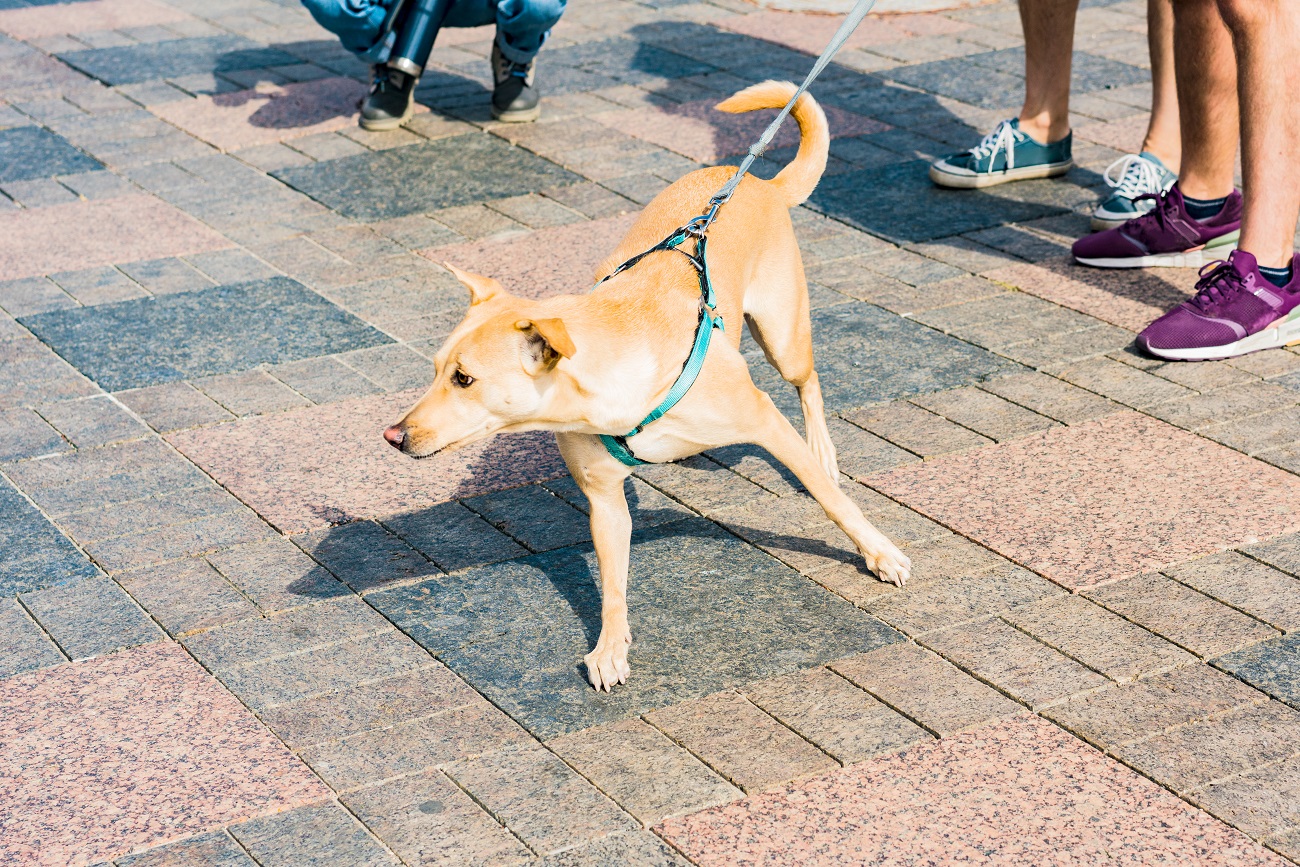
Over the past few years, I’ve lost count of the number of emails I get about leash pulling. So today, I want to touch base on one of the more common questions I get which is… “how exactly do I stop my dog pulling the leash?”
It’s sad to say, but we don’t live in a perfect world. And while we’d all like nothing more than our dogs to behave on the leash, the fact is that it’s not always going to be as smooth sailing from the get go.
Now, nobody wants to see their loveable bundle of joy turning into an overbearing nightmare.
But unfortunately, it happens so often that it can feel like a constant battle to make sure your dog doesn’t drag you down the street whenever you take them for a walk.
Worse still, it can put a huge strain on the relationship you have with your dog which can result in expensive behavior training or in worst cases, even rehoming your dog.
I speak from personal experience when I say that nobody deserves to go through this frustration. So it’s essential to try and steer your dog away from this behavior before the unthinkable happens.
But here’s the problem…
Hiring a trainer can be very expensive, and to be honest, you don’t really need to.
I’ll explain how in a minute. First, let me talk about WHY your dog seems to be so hard to train…
See, the reason you are having so much difficulty training your dog is that you’ve been training them the outdated way.
It’s not your fault though. The fault really lies with all the bad dog training information that’s out there on the Internet and elsewhere.
Most people start training their dogs using verbal cues or commands like SIT, STAY, etc. Because that’s what they have been taught to do by numerous books on dog training and by all the videos they’ve seen on the Internet.
Here’s the problem – that’s exactly how NOT to train a dog!
Why?
Because the science of animal behavior says that starting your training using verbal cues sets your dog up for failure.
Dogs that are trained only using verbal cues never get trained properly. Or at least, the training doesn’t last long.
So what’s the best way to train a dog?
The science is very clear on this – dogs are best trained by using body language. Now, this doesn’t mean that you should never use verbal cues. What it means is that you should always START your dog’s training using body language. Later on, you can bring in a verbal cue to reinforce your dog’s training.
Let me give you an example of how this works…
One of the biggest mistakes most dog owners make is that they don’t give their dogs work to do.
And this is one of the many reasons that certain dogs (ie. service dogs) are so well-behaved.
Now, by “job” or “work”, I don’t mean that a service dog is always doing something physical in nature.
Instead, what I mean is that when you give a service dog the hand signal for the DOWN cue for instance, here’s how the service dog would have been trained to think:
“My owner has now given me the job of lying down. So I will remain lying down here in this exact spot until my owner tells me to do something else because the job that my owner wants me to do for her now is to lie down.”
So unlike most “normal” dogs who think of DOWN as just a trick that they have to perform for a few seconds after which they can do whatever they feel like, service dogs think of DOWN as a serious job that they have to do with commitment, dedication, and purpose until they get their next job from their owner.
As you can imagine, it’s a dramatically different mindset!
And this mindset is the reason service dogs are so well-behaved, and so many “normal” dogs (even if they know cues like DOWN or SIT) are not.
The good news is that you can train your dog to have the same mindset as a service dog as well.
And the best part is it’s not even that hard to accomplish.
That’s why instead of just giving you a few quick tips and leaving you to figure out the rest, I want to give you something actionable you can use RIGHT NOW to stop your dog pulling the leash.
So with this in mind, I’d highly recommend taking a moment to check out the K9 Training Institute.
Just to give you a little more insight, the K9 Training Institute runs a free online dog training workshop that goes into extensive detail on the best practices and techniques to stop unwanted behaviors like leash pulling.
It’s designed to help “normal” dogs like yours develop the same level of calmness, obedience, and impulse control as service dogs.
It’s presented by Dr. Alexa Diaz (one of the top service dog trainers in the U.S.) and Eric Presnall (host of the hit Animal Planet TV show “Who Let the Dogs Out”).
The techniques described in the workshop have been a complete game changer for thousands of frustrated owners who implemented the techniques inside this free workshop. into their dog’s routine.
This is because for the first time ever, (at least that I know of) anyone has revealed the secret techniques used by the service dog training industry to train service dogs.
The best part?
These techniques work on ANY dog… regardless of age or breed.
From small breeds like Pomeranians and Chihuahuas to large breeds like English Mastiffs and Great Danes.
Even puppies as young as 6 weeks old, and untrained adult dogs as old as 13 years, have been successfully trained using the techniques inside this free workshop.
It’s not a live workshop – it’s actually pre-recorded, which means you can watch it as many times as you like.
However, while the workshop is free, I am not sure how long it’s going to stay that way, so I’d recommend checking it out while it’s still available.
So go ahead and click the link below to register for the workshop, implement the techniques Alexa reveals, and get ready to watch your dog’s behavior transform before your very eyes.
Click Here To Watch The Free Workshop & Discover How To Finally Stop Your Dog’s Frustrating, Annoying Leash Pulling Habit… Using The Same Secrets The Pro’s Use To Train Service Dogs!

Why Does My Dog Pull The Leash?
While we prefer to take a relaxed approach and have a leisurely stroll, your dogs’ excitement can often get the better of them.
The problem is, it’s a behavior that’s not always appreciated. It’s especially not appreciated when it’s allowed to go unchecked.
And therein lies the problem.
A harmless tug from a puppy might be annoying, but it’s not necessarily dangerous.
But a dog that’s allowed to get away with it could soon start to cause some serious damage. And that’s when the real problems start.
Even a dog that pulls in a gentle way needs to be taught to stop. After all, a puppy pulling the leash is one thing: a full-sized adult dog is quite another.
Basically, all leash pulling behaviors need to be treated as equal. It all needs to be discouraged.
That said, treating your dog as an individual by figuring out the root cause of their behavior is going to be crucial in determining the right modification technique.
A dog who pulls the leash because they’re scared, for example, may need to be treated quite differently from a dog who pulls because they’re aggressive.
Before jumping to the solution, take a moment to consider what could be motivating your dogs behavior.
Some of the most common reasons include:
They’re Excited
Puppies and dogs don’t want to be coupled up all day long. They want to get out and explore.
However, if you do anything to overexcite them before a walk (rattle the leash, clap your knees as though initiating a game, etc.), up goes the excitement and enthusiasm.
Pulling the leash in his situation has nothing to do with dominance or aggression. They’re simply hyped up and ready to go.
They Haven’t Been Socialized
If your dog pulls the leash to avoid (or more towards) visitors or strangers, it could be a sign that they’ve not been properly socialized.
If dogs aren’t exposed to a wide variety of people, pets, and situations from an early age. They can become anxious or fearful around anything unfamiliar.
Unfortunately, fear and anxiety can often translate into displays of unwanted leash pulling.
The problem is particularly apparent in pups who’ve experienced abuse or traumas in the past. As well as dogs who’ve spent most of their lives being passed from one temporary home to another.

They’re Possessive
All dogs are possessive to an extent (as are humans, when you think about it) but left unchecked, it can quickly develop into a problem.
While some dogs can get super possessive about high-value items like toys or food. Others can get possessive about people.
If your dog thinks they ‘own’ you. They may display undesirable behaviors at anyone who get in between you and them.
It’s a Habit
Pulling the leash is part and parcel of being a dog. They don’t necessarily understand why they’re doing it in the first place.
Eventually, they come to the conclusion that this type of behavior is just part of the game.
Some owners may even be encouraging the behavior unknowingly.
To make matters worse, an untrained dog often can’t tell the difference between what is and isn’t acceptable.
This is a huge problem, especially with larger, powerful breeds such as Rotties, Dobermans, German Shepherds to name a few.
This is also where the techniques discussed inside the K9 Training Institute’s free dog training workshop really come in handy.
Not only will you learn how to stop unwanted behavior on the leash, but you’ll also discover simple, highly effective calming exercises to keep your dog’s emotions in check.
So if you haven’t had a chance to take a look, now would be the time…
Click Here To Watch The Free Workshop & Discover How To Finally Stop Your Dog’s Frustrating, Annoying Leash Pulling Habit… Using The Same Secrets The Pro’s Use To Train Service Dogs!

How to Stop Your Dog Pulling The Leash
Before you can stop your dog from pulling the leash, you need to identify the root cause.
Although any kind of pulling should be discouraged, different motivations need different treatment.
Consider factors like your dog’s age, whether the pulling is generalized or happens in certain locations, and whether your dog displays any other fearful or aggressive behaviors.
When it comes to training, you need to think about the big picture. It might be embarrassing when your dog starts frantically dragging you down the street. But the problem is the pulling, not the destination.
If you want to address the problem, you need to address the problem, period.
For instance, trying to stop your dog from pulling towards a stranger isn’t going to work if you let them carry on pulling any other time.
Remember, dogs respond to consistency. So be mindful to keep working on discouraging negative behaviors (whether they’re playful or not) and encouraging positive ones.
Let Them Know It’s Not Appreciated
If your dog pulls, it’s very likely they’re initiating play. Even though there’s no malice behind what they’re doing, they still need to learn that it’s not appreciated.
Each time they pull, stop, turn around, and start walking in the other direction. Soon enough, they’ll connect the dots and realize that you are there to lead, not follow.
Once they understand that, you should see a dramatic improvement.
If your own a pup that is starting to reach adolescence but is still hanging onto their obsessive pulling habit, apply the same strategy. Providing you’re consistent with the message, it won’t take too long for them to cotton on.

Avoid Provocative Games
If a dog has a lot of pent-up energy, finding a new outlet for their energy before you go for a walk is crucial.
So stick to games that allow your dog to let off some steam without engaging in any undesirable behaviors.
Avoid Negative Punishment
If your dog continues to pull, don’t use punishment as a corrective method.
This means no yelling, no slapping, and nothing that could hurt or frighten your dog.
Not only does behavior like this make your dog scared of you, but it also risks turning an annoying behavior into an aggressive one.
Win your Dog’s Mind
Here’s one of the most important lessons that can be summed up in a few simple words…
…”It’s about winning your dog’s mind first”
See, dogs come in all shapes and sizes.
Some are naturally mild-mannered and calm…
…Some can be a little overbearing at times.
…And some are just downright Crazy with a capital “C”
But the one thing they all have in common is they respect the pack leader.
Now, if you’re one of the lucky few, your dog may already see you as the pack leader.
Other times, it may a little time and effort to steer them in the right direction.
And if you’re one of the very unlucky ones (as many are), getting your dog to stop pulling the leash is about as easy as getting a toddler to take a nap after 6 cans of Redbull.
But no matter what your situation, getting your dog on the path to success will always come down to the same thing…
…Winning their mind.
Flashback to when I was a young inexperienced puppy parent.
It was one of the most stressful times of my life.
And here’s the thing…
It wasn’t that I was applying the wrong training techniques to my pup’s routine.
Far from it…
It was because I was missing the critical step of winning his mind first.
Once I got my head around this, everything instantly fell into place.
This is also why it’s a HUGE MISTAKE to train your dog without first getting to grips with this one core principle.
Now, instead of just giving you a few tips and sending you on your way. I think it would benefit you much more if I were to give you something actionable that you can start using immediately to see results.
So with this in mind, go ahead and check out the K9 Training Institute’s free dog training workshop.
I’m confident that if you watch the training and follow the advice Alexa reveals inside the workshop, you’ll start to notice the immediate effect it has on your dog’s behavior for the better.
Click Here To Watch The Free Workshop & Discover How To Finally Stop Your Dog’s Frustrating, Annoying Leash Pulling Habit… Using The Same Secrets The Pro’s Use To Train Service Dogs!
Here’s What You’ll Learn Inside This Free Workshop
In the free workshop, you’ll discover:
– The secret methods that service dog trainers use to housebreak dogs
So that your dog never has accidents inside your house ever again.
– How service dogs are trained to never bark out of excitement
Contrary to what many people believe, you CAN’T stop a dog from letting you know that someone has come to your front door – they are simply hard wired for it. Instead, find out the “QUIET WAY” that you can teach your dog so that it still gets to alert you to strangers – without barking even once.
– Why service dogs behave so well when walking on the leash without pulling
So that you can leash train your dog just like a service dog.
– How service dogs are trained to ALWAYS come when called
So that your dog too will come back to you the moment you say its name in the dog park or anywhere else (no matter what it might have been doing at that time).
– How the pros train their dogs to stop jumping on people
So that your dog learns to calmly greet people who come over to your house.
– The secret methods that service dog trainers use to train their dogs to tune out distractions
So that your dog stays calm and doesn’t react at all when passing by other dogs.
– How service dog trainers train their dogs mainly using body language
So that you can get your dog’s attention in public situations without having to raise your voice or use verbal commands.
– How service dogs do more than follow commands – they read their human partners in demonstrable and extraordinary ways
And how your dog can too!
– Why the training techniques that work on service dogs also work on dog breeds that are typically not thought of as service dogs
This means that these techniques will work on your dog even if it’s a breed – like a Chihuahua, Rottweiler, Akita, etc. – that is usually not considered a breed suitable for being a service dog.
Click Here To Watch The Free Workshop & Discover How To Finally Stop Your Dog’s Frustrating, Annoying Leash Pulling Habit… Using The Same Secrets The Pro’s Use To Train Service Dogs!
What Others Are Saying About The Free Workshop
“Guess what, my Chihuahua is completely housebroken now! I used to have so much difficulty getting Frankie to not do his business all over my house. I used your methods to housetrain him and it has worked wonders on him!”
– Amanda Silver from Glasgow, Scotland
———-
“I used your tips to start training my Yorkshire Terrier puppy Grace a few weeks after I got her. With just a few days of training, I have managed to get Grace to come when called and stop pulling on her leash.
She is also completely housebroken now. I am so happy I discovered your site. I have had other dogs in the past, but none of them were as easy to train as Grace has been thanks to your site.”
– Cassandra Wallace from Scranton, Pennsylvania
———-
“My beautiful Doberman Sophie was completely out of control. With your workshop, I learned how to make it obvious to her what was not acceptable.
And she got it too. Amazing results.”
– Gina Meyer (Sophie’s Mom) from Galveston, Texas
———-
“I rescued a 3.5 year old German Shepherd from the shelter a few months ago. The poor thing had not been trained properly by his previous owners and was quite aggressive and skittish and used to bark for no reason at all.
I came across your site while searching for ways to train him and am so glad I did. Thanks to your workshop, he is now a lot calmer and friendlier towards everyone and the barking has almost completely stopped now.”
– Matt Jenson from Rockford, Illinois
———-
“I wanted to pass along a sincere thank you for helping out so much in Milo’s first year. He is almost 2 now and incredibly well-behaved.
I am incredibly grateful for your guidance and help. Thank you again!”
– Christina Appleton from Buffalo, New York

Final Thoughts
In a lot of cases, a dog that pulls is doing it out of play rather than aggression. But that doesn’t mean it’s ok to let it continue.
The sooner your dog learns that it is not ok, the better.
Not only does it decrease the risk of those gentle tugs turning into something more serious down the line. But it also makes it way less embarrassing around others.
Find the root cause and apply the solution. That might be easier said than done, but with a hefty dose of consistency and patience, you’ll get there.
Want To Learn 3 Simple Techniques You Can Use RIGHT NOW To Stop Your Dogs Frustrating, Annoying Leash Pulling Habit?
Let me ask you this…
- Is your dog dragging you down the street?
- Do they pull you in every direction every time you step outside?
- Are they refusing to walk calmly by your side?
- Want a quicker, easier way to calm them down?
